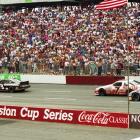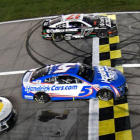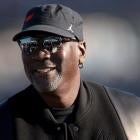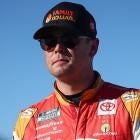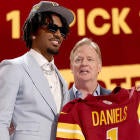
It wasn't long ago that it hurt Mike Staley to pass by North Wilkesboro Speedway and see what the track had become.
The short NASCAR track that was once owned and operated by his father Enoch -- a charter member of NASCAR and one of the most influential figures in the sport's early history -- had wasted away as a fossil of a bygone era. Weeds and growth protruded through the track's asphalt, as if being reclaimed by North Carolina's foothills.
All else that lined the track -- left as it was after the mid-1990s -- was rusting and crumbling, seemingly never to return to the former glory.
"It was like taking a bandage off and pulling the scab off and feeling bad," Staley told CBS Sports.
For the better part of the last quarter century, the state of North Wilkesboro Speedway in Wilkes County, N.C. had represented the price of progress of NASCAR's ascent from a regional curiosity to national relevance. Located in the same moonshine country where stock car racing began, North Wilkesboro had been an important annual stop on the Cup Series calendar from its inaugural season in 1949 onwards.
Red Byron, NASCAR's first champion, had been crowned there. So too were many of the sport's most iconic drivers, such as household names like Petty, Allison, Waltrip, Earnhardt. But by the 1990s, North Wilkesboro had fallen behind the times and behind the ambitions of NASCAR. The sponsorship market had boomed, meaning an influx of corporate money and influence had entered the sport with great enthusiasm -- but not for North Wilkesboro.
The track lacked the modern amenities and creature comforts that had come to be featured at other racetracks, and its lack of highway access -- and ensuing traffic issues before and after events -- was a major problem. There was also the issue of a growing distaste for short tracks like it: where a generation of drivers and fans saw some of NASCAR's most timeless speedways, stock car racing's new vision saw drab facilities in the middle of nowhere, where the high-contact racing presented an image that was felt to be too rough and unsophisticated.
Then came NASCAR's track-building boom of the mid-1990s. New, state of the art speedways popped up in major markets like Speedway Motorsports Inc.'s new Texas Motor Speedway in Dallas-Fort Worth.
That all led to the logical -- from a dollars-and-cents standpoint -- decision to move North Wilkesboro's two race dates to larger markets.
Shortly after Enoch Staley died of a stroke in May 1995, the track's fate was sealed. Half of the family-owned speedway was sold to SMI, who moved one of its dates to Texas starting in 1997. The other half was sold to Bob Bahre, who moved the track's other date to his New Hampshire Motor Speedway in New England.
"The idea of going from Wilkes County, North Carolina -- a short track -- to a big market, a big world-renowned city like Dallas-Fort Worth, it was kind of a no-brainer. But of course if you lived in Wilkes County or Western North Carolina, it was not a great thing," Marcus Smith, the CEO of Speedway Motorsports, told CBS Sports. "But the sport, it was going fast. It was in high gear, and some things got left behind in the process."
In a cruel twist of fate, the thing that made the track special in the first place is partially what led to its original demise, Staley said.
"Progress is what made the track where it is in that point in time, and progress is what basically took it away from you. Because they needed bigger venues and bigger cities and more highways, and we just had a two-lane road and really couldn't expand that much more," Staley said. "I could see the writing on the wall.
"My sisters and Mom kind of didn't want to sell, but there was no way we could go against a big corporation and not sell."
In Wilkes County, raw emotions accompanied the final race at North Wilkesboro in the fall of 1996.
NASCAR Hall of Famer Junior Johnson, Wilkes County's greatest local icon for his racing and moonshining exploits, could not bring himself to attend the track's last event. There was a strong sentiment of anger towards Speedway Motorsports CEO Bruton Smith, who became vilified among locals -- much like Art Modell when he moved the original Cleveland Browns to Baltimore around the same time -- for being the chief force behind the track's closure.
The track closing foreshadowed what was becoming of the local economy.
The Carolina Mirror Company, once the largest mirror factory in America, was among the factories that closed nearby around the time. Corporations like Lowe's moved offices that had been in Wilkes County to larger surrounding cities like Charlotte and Winston-Salem. The burden of all this fell on the people of Wilkes County, as their median household income declined by over 30% from 2000 to 2014. Unemployment, poverty, and vacant storefronts all factored into Wilkes County becoming one of the most economically-distressed areas in North Carolina.
But even as NASCAR went on without it, there was still hope as long as North Wilkesboro Speedway still stood. And as local figures tried to stem the tide of decline and revitalize Wilkes County, the track was many times cited as a potential lynchpin for the area's chances of economic revival.
Slowly but surely, that hope would be rewarded in an unlikely manner.
Although Marcus Smith had felt the track was too far gone to ever be feasible for racing again, North Wilkesboro was still among SMI's portfolio of properties. And in 2019, Smith was part of a group of prominent NASCAR figures that cleaned North Wilkesboro so that it could be scanned and preserved digitally through iRacing's racing simulation software.
"We came out and we did the scanning, but that event created this groundswell of hope," Smith said. "And hope is very powerful."
Then, in 2021, an influx of state money through the American Rescue Plan created previous unthinkable funds for the restoration of the speedway, making it financially feasible to restore and resurrect the speedway for at least grassroots-level racing
All the while, the efforts of locals and race fans to save the speedway continued to grow.
The significance of Bruton Smith's son being one of the major driving forces behind North Wilkesboro's revival has hardly been lost. For as difficult as resurrecting the speedway seemed to be and as much as was said locally about his father (the elder Smith died in June of 2022), it arguably would have been easy for Marcus Smith to simply wash his hands of North Wilkesboro and once and for all declare it lost to time.
Instead, North Wilkesboro's revival has become a sort of passion project -- a "resto-mod," as he calls it -- of Smith's. One that could not possibly have been more appreciated when it was announced that the track would return to the NASCAR Cup Series schedule as the host of the All-Star Race in 2023.
"It's just been amazing. Very touching," Smith said of Wilkes County's response. "I've been able to talk with a lot of fans that have been here many, many times in the past. And they're so thankful to be able to return and see a race at a place that represents a lot of their childhood and their earlier years. People that came as kids, or people that now have grandchildren, you name it.
"It's a wide, wide variety of people that are coming from near and far, so excited to be able to come back to this special place where memories were made."
Incredible. #AllStarRace | #NASCAR75 pic.twitter.com/nn8sq4d2Yq
— NASCAR (@NASCAR) May 17, 2023
The rebirth and restoration of North Wilkesboro mirrors what has been a long-awaited economic comeback for Wilkes County. Now, the hope is that the national spotlight from the Speedway's revival and the return of NASCAR can further spur and inspire growth in the area. For Wilkes County, holding out hope left them fulfilled and gave them their racetrack back in a form apt for NASCAR's present day while still preserving a vintage feel.
"Now I go down there," Staley says of seeing North Wilkesboro, "and it's just eye candy."













